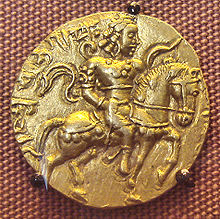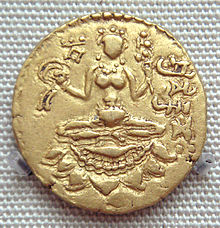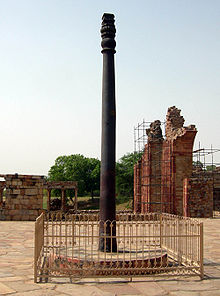- Chandragupta II
-
Chandragupta II the Great (Vikramaditya) Gupta Emperor 
Coin of Chandragupta II the Great, British Museum.Reign 375–415 CE Predecessor Ramagupta Successor Kumara Gupta I Consort Dhruvuswamini Royal House Gupta dynasty Father Samudra Gupta Mother Datta Devi Religious beliefs Hinduism Chandragupta II the Great, very often referred to as Vikramaditya or Chandragupta Vikramaditya in Sanskrit; was one of the most powerful emperors of the Gupta empire in northern India. His rule spanned c. 380–413/415 CE, during which the Gupta Empire achieved its zenith, art, architecture, and sculpture flourished, and the cultural development of ancient India reached its climax.[1] The period of prominence of the Gupta dynasty is very often referred to as the Golden Age of India. Chandragupta II was the son of the previous ruler, Samudragupta the Great. He attained success by pursuing both a favorable marital alliance and an aggressive expansionist policy in this which his father and grandfather (Chandragupta I) set the precedent. Samudragupta set the stage for the emergence of classical art, which occurred under the rule of Chandragupta II. Chandragupta II gave great support to the arts. Artists were so highly valued under his rule that they were paid for their work — a rare phenomenon in ancient civilizations.[2]
From 388 to 409 he subjugated Gujarat, the region north of Mumbai, Saurashtra, in western India, and Malwa, with its capital at Ujjain.[3] Culturally, the reign of Chandragupta II marked a Golden Age. This is evidenced by later reports of the presence of a circle of poets known as the Nine Gems in his court. The greatest among them was Kalidasa, who authored numerous immortal pieces of literature including Abhijñānaśākuntalam. The others included Sanskrit grammarian Amara Sinha and the astronomer-mathematician Varahamihira.[citation needed]
Contents
Mentions in literature
Not much is known about the personal details of Chandragupta II. The most widely accepted details have been built upon the plot of the play Devi-chandraguptam by Vishakadatta. The play is now lost, but fragments have been preserved in other works (such as Abhinava-bharati, Sringara-prakasha, Natya-darpana, Nataka-lakshana Ratna-kosha). There even exists an Arabic work Mojmal al-tawarikh (12th century CE) which tells a similar tale of a king whose name appears to be a corruption of 'Vikramaditya'. The name 'Vikramaditya' holds a semi-mythical status in India. India has many interesting stories about King Vikramaditya, his guru Manva-Patwa and his queens. It is widely believed that the great poet in Sanskrit, Kalidasa was one of the jewels of Vikramaditya's royal court.
Biography
Early life and coronation
Chandragupta II's mother, Datta Devi, was the chief queen of Samudragupta the Great. After Samudragupta's death his elder son, Ramagupta, took over the throne and married Chandragupta II's fiance Dhruvaswamini by force. The fragment from Vishakadatta's "Natya-darpana" mentions the king Ramagupta, the elder brother of Chandragupta II, deciding to surrender his queen Dhruvaswamini to the Saka ruler of the Western Kshatrapas Rudrasimha III (r. 388 - 395 CE), after a defeat at the Saka ruler's hands. To avoid the ignominy the Guptas decide to send Madhavasena, a courtesan and a beloved of Chandragupta II, disguised as the queen Dhruvaswamini. Chandragupta II changes the plan and himself goes to Rudrasimha III disguised as the queen. He then assassinates Rudrasimha III and later his brother Ramagupta. Dhruvaswamini is then married to Chandragupta II.
Historians still don't know what liberties the author Vishakadatta took with the incidents, but Dhruvadevi was indeed Chandragupta II's Chief Queen as seen in the Vaisali Terracotta Seal that calls her "Mahadevi" (Chief Queen) Dhruvasvamini. The Bilsad Pillar Inscription of their son Kumaragupta I (r. 414–455 CE) also refers to her as "Mahadevi Dhruvadevi". Certain "Ramagupta" too is mentioned in inscriptions on Jain figures in the District Archaeological Museum, Vidisha and some copper coins found at Vidisha.
The fact that Chandragupta II and Dhruvadevi are the protagonists of Vishakadatta's play indicates that marrying his widowed sister-in-law was not given any significance by the playwright. Later Hindus did not view such a marriage with favour and some censure of the act is found in the Sanjan Copper Plate Inscription of Rashtrakuta ruler Amoghavarsha I (r. 814-878 CE) and in the Sangali and Cambay Plates of the Govinda IV (r. 930-936 CE).
Vakataka-Gupta Age
The Allahabad Pillar Inscription mentions the marriage of Chandragupta II with a Naga princess Kuberanaga. A pillar from Mathura referring to Chandragupta II has recently been dated to 388 CE.[4]
Chandragupta II's daughter, Prabhavati Gupta, by his Naga queen Kuberanaga was married to the powerful Vakataka dynasty ruler Rudrasena II (r.380-385 CE).
His greatest victory was his victory over the Shaka-Kshatrapa dynasty and annexation of their kingdom in Gujarat, by defeating their last ruler Rudrasimha III.
Chandragupta II's son-in-law, the Vakataka ruler Rudrasena II, died fortuitously after a very short reign in 385 CE, following which Queen Prabhavati Gupta (r. 385-405) ruled the Vakataka kingdom as a regent on behalf of her two sons. During this twenty-year period the Vakataka realm was practically a part of the Gupta empire. The geographical location of the Vakataka kingdom allowed Chandragupta II to take the opportunity to defeat the Western Kshatrapas once for all. Many historians refer to this period as the Vakataka-Gupta Age.
Chandragupta II controlled a vast empire, from the mouth of the Ganges to the mouth of the Indus River and from what is now North Pakistan down to the mouth of the Narmada. Pataliputra continued to be the capital of his huge empire but Ujjain too became a sort of second capital. The large number of beautiful gold coins issued by the Gupta dynasty are a testament to the imperial grandeur of that age. Chandragupta II also started producing silver coins in the Saka tradition.
Visit of Faxian
 Coin of Vikramadytia Chandragupta II with the name of the king in Brahmi script, 380–415 CE.
Coin of Vikramadytia Chandragupta II with the name of the king in Brahmi script, 380–415 CE.
Faxian (337 – c. 422 CE) was the first of three great Chinese pilgrims who visited India from the fifth to the seventh centuries CE, in search of knowledge, manuscripts and relics. Faxian arrived during the reign of Chandragupta II and gave a general description of North India at that time. Among the other things, he reported about the absence of capital punishment, the lack of a poll-tax and land tax. Most citizens did not consume onions, garlic, meat, and wine.[citation needed]
Campaigns against foreign tribes
4th century CE Sanskrit poet Kalidasa, credits Chandragupta Vikramaditya with having conquered about twenty one kingdoms, both in and outside India. After finishing his campaign in the East and West India, Vikramaditya (Chandra Gupta II) proceeded northwards, subjugated the Parasikas (Persians), then the Hunas and the Kambojas tribes located in the west and east Oxus valleys respectively. Thereafter, the king proceeds across the Himalaya and reduced the Kinnaras, Kiratas etc. and lands into India proper.[5] The Brihatkathamanjari of the Kashmiri writer Kshmendra states, king Vikramaditya (Chandra Gupta II) had "unburdened the sacred earth of the Barbarians like the Sakas, Mlecchas, Kambojas, Yavanas, Tusharas, Parasikas, Hunas, etc. by annihilating these sinful Mlecchas completely".[6][7][8]
End of Chandragupta II
Chandragupta II was succeeded by his second son Kumaragupta I, born of Mahadevi Dhruvasvamini.[9]
Religion
From Chandragupta II kings of Gupta dynasty are known as Parama Bhagavatas or Bhagavata Vaishnavas.
The Bhagavata Purana entails the fully developed tenets and philosophy of the Bhagavata tradition wherein Krishna gets fused with Vasudeva and transcends Vedic Vishnu and cosmic Hari to be turned into the ultimate object of bhakti.[10]
 Silver coin of Chandragupta II the Great, minted in his Western territories, in the style of the Western Satraps.
Silver coin of Chandragupta II the Great, minted in his Western territories, in the style of the Western Satraps.
Obv:Bust of king, with corrupted Greek legend "OOIHU".[11][12]
Rev: Legend in Brahmi, "Chandragupta Vikramaditya, King of Kings, and a devotee of Vishnu" , around Garuda, the mythic eagle and dynastic symbol of the Guptas.
15mm, 2.1 grams. Mitchiner 4821-4823.Coinage
Chandragupta continued issuing most of the gold coin types introduced by his father Samudragupta, such as the Sceptre type (rare for Chandragupta II), the Archer type, and the Tiger-Slayer type. However, Chandragupta II also introduced several new types, such as the Horseman type and the Lion-slayer type, both of which were used by his son Kumaragupta I.
In addition, Chandragupta II was the first Gupta king to issue silver coins, such as the one illustrated at right. These coins were intended to replace the silver coinage of the Western Kshatrapas after Chandragupta II defeated them, and were modeled on the Kshatrapa coinage. The main difference was to replace the dynastic symbol of the Kshatrapas (the three-arched hill) by the dynastic symbol of the Guptas (the mythic eagle Garuda). Further, Chandragupta also issued lead coins based on Kshatrapa prototypes and rare copper coins probably inspired by the coins of another tribe he defeated, the Nagas.
Vikram-Samvat Calender
The next day after the Hindu festival Diwali is called Padwa or Varshapratipada, which marks the coronation of King Vikramaditya. The Hindu Vikram-Samvat calendar was apparently started on this day and this day is celebrated as New Year's Day in Nepal where Vikram Sambat is the official calendar and in some places in India. But, Vikram-Samvat calender is from 57 BCE. So, there was someother king by name Vikram, who started this calender. Shak-Samvat is synchronised with the Saka-Samvat calendar, which starts around April. This calendar was initiated by Gautamiputra Satakarni who defeated the Saka king Vikramaditya, thus starting the Shalivahana era or Shaka Calendar[citation needed]
Iron pillar of Delhi
Main article: Iron pillar of DelhiThe iron pillar of Delhi, erected by Chandragupta II the Great
Close to the Qutub Minar is one of Delhi's most curious structures, an iron pillar, dating back to 4th century CE. The pillar bears an inscription which states that it was erected as a flagstaff in honour of the Hindu god Vishnu, and in the memory of Chandragupta II (A derivation of "Natya-darpana" by Vishakadata states that the pillar had been put up by Chandragupta II himself after defeating Vahilakas. And after this great feat, he put up this pillar as a memory of the victory). The pillar also highlights ancient India's achievements in metallurgy. The pillar is made of 98% wrought iron and has stood more than 1,600 years without rusting or decomposing. This iron pillar is similar to the pillars of Asoka.
Notes
- ^ <http://www.britannica.com/EBchecked/topic/92493/Chandra-Gupta-II>.
- ^ AUTHOR ushistory.org TITLE OF PAGE The Gupta Period of India TITLE OF PROGRAM Ancient Civilizations Online Textbook URL OF PAGE http://www.ushistory.org/civ/8e.asp DATE OF ACCESS Thursday, November 10, 2011 COPYRIGHT 2011
- ^ <http://www.britannica.com/EBchecked/topic/92493/Chandra-Gupta-II>.
- ^ Falk, Harry. (2004) "The Kaniṣka era in Gupta Records." Silk Road Art and Archaeology 10. Kamakura: The Institute of Silk Road Studies, pp. 167-176.
- ^ Raghu Vamsa v 4.60–75
- ^ ata shrivikramadityo helya nirjitakhilah Mlechchana Kamboja. Yavanan neechan Hunan Sabarbran Tushara. Parsikaanshcha tayakatacharan vishrankhalan hatya bhrubhangamatreyanah bhuvo bharamavarayate (Brahata Katha, 10/1/285-86, Kshmendra).
- ^ Kathasritsagara 18.1.76–78
- ^ Cf:"In the story contained in Kathasarit-sagara, king Vikarmaditya is said to have destroyed all the barbarous tribes such as the Kambojas, Yavanas, Hunas, Tokharas and the Persians "(See: Ref: Reappraising the Gupta History, 1992, p 169, B. C. Chhabra, Sri Ram; Cf also: Vikrama Volume, 1948, p xxv, Vikramāditya Śakāri; cf: Anatomii͡a i fiziologii͡a selʹskokhozi͡a ĭstvennykh zhivotnykh, 1946, p 264, Arthur John Arberry, Louis Renou, B. K. Hindse, A. V. Leontovich, National Council of Teachers of English Committee on Recreational Reading – Sanskrit language.
- ^ Agarwal, Ashvini (1989). Rise and Fall of the Imperial Guptas, Delhi:Motilal Banarsidass, ISBN 81-208-0592-5, pp.191–200
- ^ Kalyan Kumar Ganguli: (1988). Sraddh njali, Studies in Ancient Indian History: D.C. Sircar Commemoration: Puranic tradition of Krishna. Sundeep Prakashan. ISBN 8185067104.p.36
- ^ "The conquest is indicated by the issue of the new Gupta silver coinage modelled on the previous Saka coinage showing on observe the King's head, Greek script, and dates as on Saka coins" in Early history of Jammu region: pre-historic to 6th century A.D. by Raj Kumar p.511
- ^ "Evidence of the conquest of Saurastra during the reign of Chandragupta II is to be seen in his rare silver coins which are more directly imitated from those of the Western Satraps... they retain some traces of the old inscriptions in Greek characters, while on the reverse, they substitute the Gupta type (a peacock) for the chaitya with crescent and star." in Rapson "A catalogue of Indian coins in the British Museum. The Andhras etc...", p.cli. Most people now realize that Rapson was mistaken in identifying the central bird as a peacock; rather, it is the mythic eagle Garuda, the dynastic symbol of the Guptas. For example, A.S. Altekar says: "... the three-arched hill in the cntre is replaced by Garuda, which was the imperial insignia of the Guptas. The view of earlier writers ... that the bird is a peacock is clearly untenable." in Altekar: The Coinage of the Gupta Empire," Varanasi: Banaras Hindu University, 1957, p. 151.
References
- R. K. Mookerji, The Gupta Empire, 4th edition. Motilal Banarsidass, 1959.
- R. C. Majumdar, Ancient India, 6th revised edition. Motilal Banarsidass, 1971.
- Hermann Kulke and Dietmar Rothermund, A History of India, 2nd edition. Rupa and Co, 1991.
External links
See also
Regnal titles Preceded by
Samudragupta the GreatGupta Emperor
375–414Succeeded by
Kumara Gupta ICategories:- 410s deaths
- Gupta dynasty
- Indian monarchs
- History of Malwa
- 4th-century monarchs in Asia
- 5th-century monarchs in Asia
Wikimedia Foundation. 2010.



